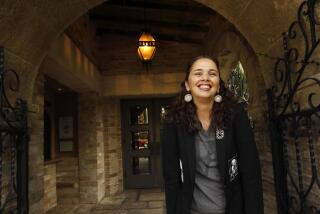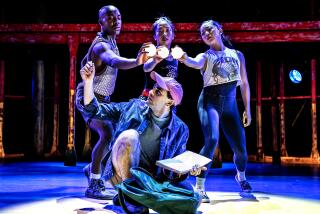Strong Sense of Purpose Holds Ailey Troupe Aloft
A sense of moral vision is rare enough in people these days that to find it informing a whole program of otherwise dissimilar dance works seems to explain why the Alvin Ailey American Dance Theatre looks so triumphant 10 years after its founder’s death. Opening a six-performance engagement at the Ahmanson Theatre on Wednesday, the company simply danced from a deeper impetus than most others ever do, never relying on empty technical display or celebratory high spirits when it could make a more profound connection to its choreographies.
Indeed, you could argue that much of Ailey’s classic “Revelations” appeared a mite studied and even somber in the very polished performance Wednesday--overworked for movement details and expressive implications in the “Fix Me Jesus” duet (slowed down from its original tempo), and never free enough to be properly engulfing in the great “Wade in the Water” sequence. It’s as if nothing could be taken for granted or executed lightly in this masterwork of black spirituality lest it be lost--as if this company is dancing for history.
As it happened, the new production of Geoffrey Holder’s 31-year-old “Prodigal Prince” showed how seeing oneself in relation to a historical tradition can help heal and empower. Drawing its premise from the life of Haitian painter Hector Hyppolite, the work juxtaposed splashy evocations of Caribbean and African ritual, using these cultural panoramas to inspire Hyppolite’s progress toward self-awareness and creative focus.
As in his ensemble showpieces for Dance Theatre of Harlem, Holder proved himself a resourceful composer, a brilliant designer of sets and costumes, a master of exotic processional movement and also a creator of intriguing gestural statements--but pretty much a dud when it came to inventing, developing or sustaining steps. Yes, brief outbursts of dancing did periodically occur, but they never led anywhere or served to develop the character of Hyppolite, played with heroic fervor by Matthew Rushing.
That fervor prevented Hyppolite from becoming merely a pretext for a spectacular costume parade, one that began with his own crimson pajamas and included the ensemble’s red and white Voudoun attire, the women’s African dresses with hand-of-Fatima motifs and nine gold-unto-orange robes for men that made the dancers seem to burn in the air as they whirled. Wearing a blue gown in the opening and closing scenes and a nude-look bodysuit with plumed headdress in the central “Dream of Africa” section, Briana Reed danced intently, never letting the costumes mask her authority. In simpler attire, Renee Robinson energized the Voudoun healing rite, and Edward Franklin brought exceptional sweetness and precision to the movement scraps that formed the role of St. John the Baptist.
In his new “Lettres D’Amour,” French choreographer Redha also designed his own costumes but avoided anything like Holder’s glowing colors in favor of layering black fabric on black bodies against black stage curtains. Dressing and undressing became a key motif in this multi-part study of relationships, with nine recordings, from pop to contemporary classical, spliced together as accompaniment.
In subject matter and monochromatic bleakness of design, the work obviously belonged to current European dance-theater trends, but its emphasis on nonstop dancing made it a potent American-style showpiece as well. The contexts for prowess might be utterly conventional--as in the balletic duet for Rushing and Linda-Denise Evans at the very end. Or they might be blazingly original--as in the sequence in which moving spotlights stalked and seduced Robinson. But most of the time they came from character values, the element giving “Lettres D’Amour” its structural unity and dramatic force.
If you wanted, you could penetrate Redha’s dense, simultaneous group action by concentrating on certain individuals and following them through the work--Bahiyah Sayyed and Benoit-Swan Pouffer, for instance, who linked up right after the opening only to part just before the end. You could see Lynn Barre representing a lonely but powerful single in this world of couples and, during the solo of solos, watch Richard Witter’s amazing virtuosity define a desperate search for identity and completeness. Redha offered plenty to think about and marvel at in a complex, challenging creative statement that promises to grow richer with repeated viewings.
* The Alvin Ailey company repeats this program tonight at 8, dancing other works on Saturday at 2 and 8 p.m. and Sunday at 3 p.m. Ahmanson Theatre, Music Center, 135 N. Grand Ave. $20-$50. (213) 365-3500.
More to Read
The biggest entertainment stories
Get our big stories about Hollywood, film, television, music, arts, culture and more right in your inbox as soon as they publish.
You may occasionally receive promotional content from the Los Angeles Times.










